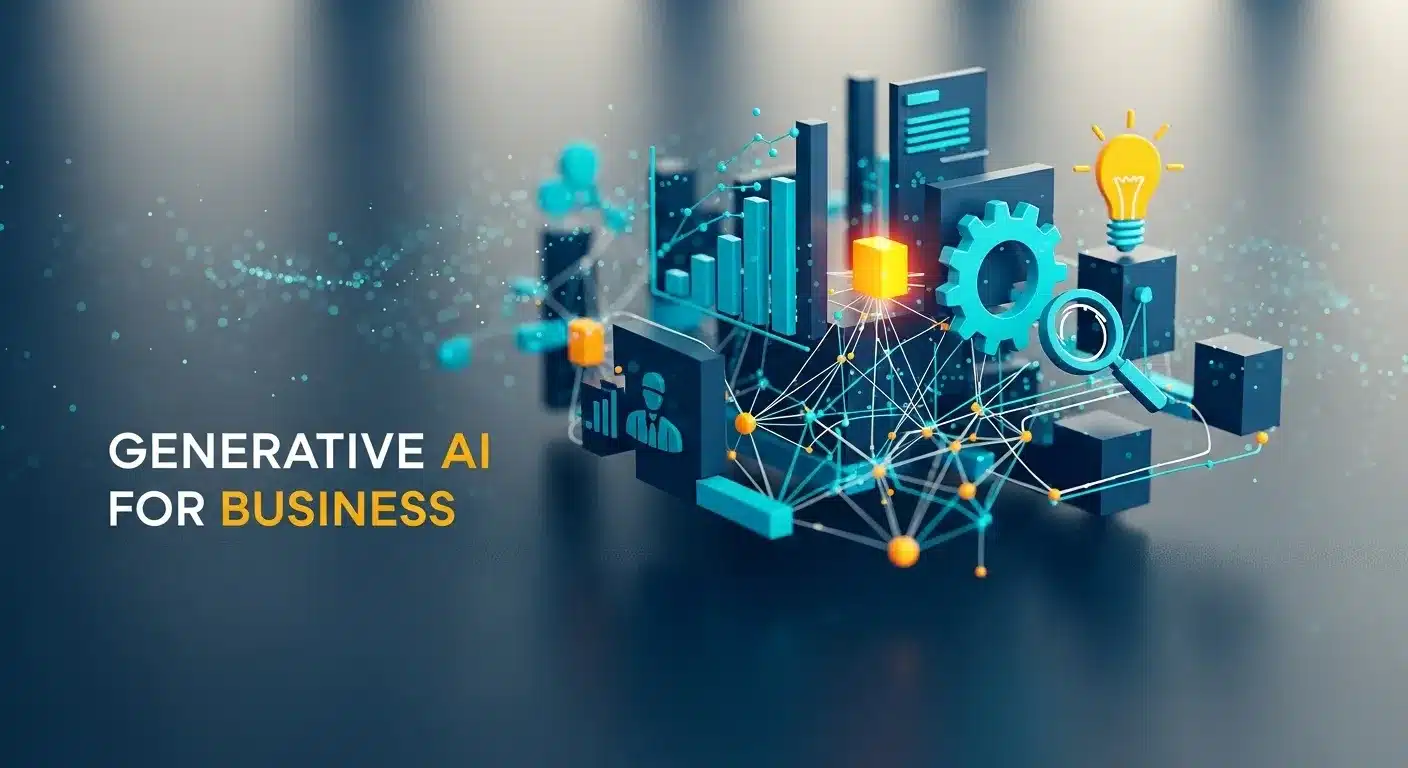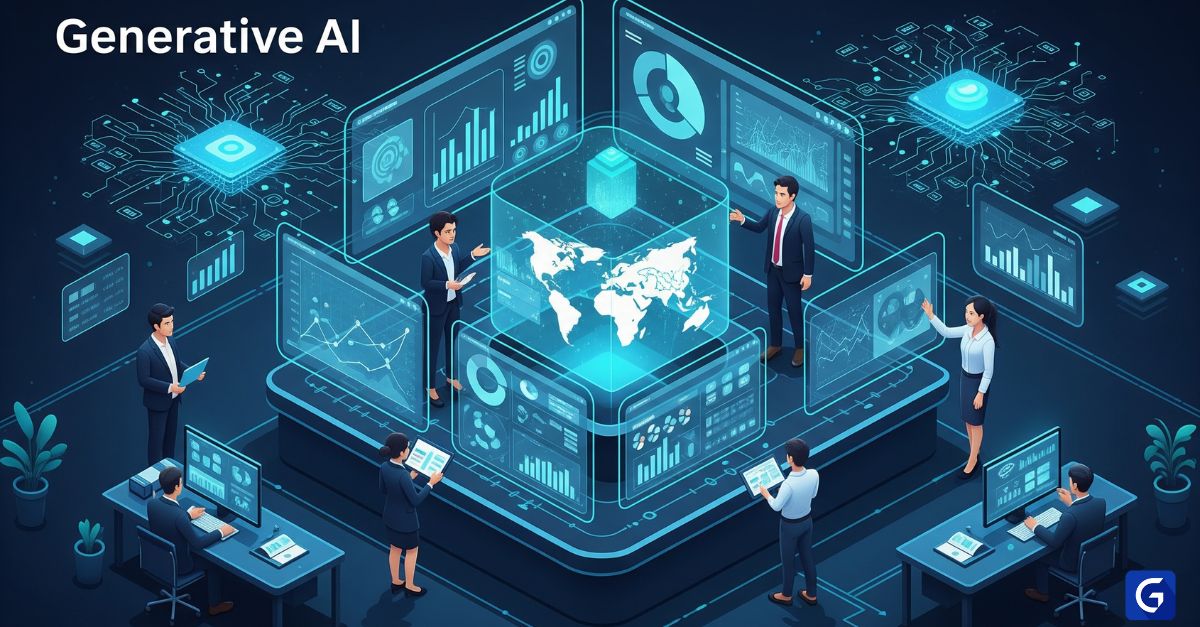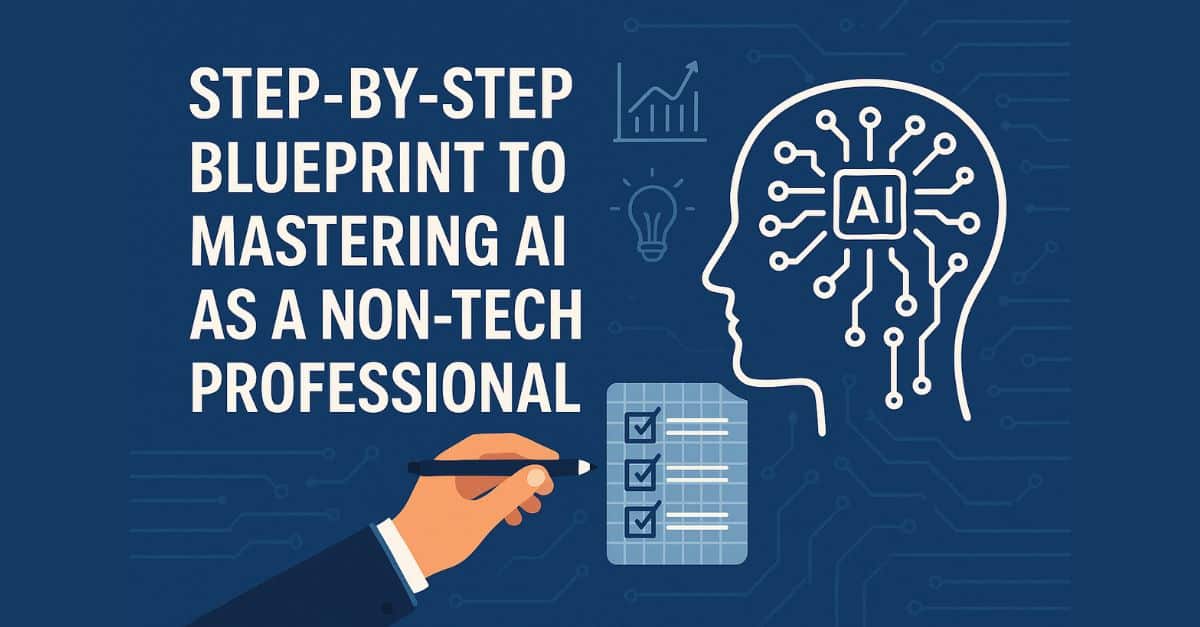- Workforce Productivity & Efficiency Challenges Businesses Face
- Generative AI as a Productivity Multiplier
- Real-World Applications: Generative AI in Action
- Framework: The 70–20–10 Model of AI-Powered Work
- Unique Benefits for Workforce Productivity
- Challenges Businesses Must Navigate
- Four Stages of Generative AI Adoption in the Workforce
- The Future Workforce: AI-Integrated Teams
- Comparison: Traditional AI vs. Generative AI
- Summary
- Conclusion
- Frequently Asked Questions(FAQ’s)
The current generation is working harder than before. Companies should be capable of producing results within a shorter time, operating in small groups, and be creative to be competitive. Traditional automation has worked well in the routine tasks, but it is prone to failure where creativity, judgment, or problem-solving is required.
That’s where generative AI for business comes in. Instead of just processing data, it produces useful outputs, like reports, presentations, emails, code, and designs, at scale. Rather than replacing employees, it works alongside them, taking over repetitive work so people can focus on projects that drive growth.
In this article, we’ll look at how businesses are using generative AI to improve productivity and efficiency, with real examples, measurable results, and a roadmap for adoption.
Workforce Productivity & Efficiency Challenges Businesses Face
Before understanding how AI solves problems, let’s look at what slows employees down:
- Repetitive Administrative Work: Employees dedicate up to 58 per cent of their working hours to tasks such as email writing, timekeeping, and report writing.
- Information Overload: Employees have to deal with large amounts of information before arriving at decisions, and it slows down action.
- Talent Shortages: Skill deficits on data analysis, coding and digital tools add load to a small number of employees.
- Customer Demands: The customers want to be served instantly and personally, manual operations are not able to meet the demand.
- Time-to-Market Pressure: Companies must be able to innovate more quickly, yet the traditional operations introduce bottlenecks.
Learn the foundations that power AI by exploring this guide on What is Artificial Intelligence?
Generative AI would solve all of these by performing repetitive duties, automating the production of documents, making decisions faster, and scaling customer interaction without the need of increasing the number of personnel.
Generative AI as a Productivity Multiplier
Generative AI is not about incremental efficiency, it’s about reshaping how work gets done.
- A 2023 MIT study showed that generative AI boosted knowledge worker productivity by 37%, especially in drafting business documents.
- McKinsey research suggests generative AI could add $4.4 trillion annually to the global economy by improving workforce productivity.
- Microsoft 365 Copilot users save 10 or more hours a week on emails, meeting summaries, and financial reports.
Rather than cutting down on the workforce, businesses view generative AI as a force multiplier, allowing smaller work teams to produce the results of much larger work teams.
Real-World Applications: Generative AI in Action
1. Customer Support at Scale
- Klarna, the fintech company, replaced parts of its customer service workflow with generative AI.
- Outcome: Ticket resolution time cut by 25%, while maintaining customer satisfaction.
2. Marketing & Creative Campaigns
- Coca-Cola partnered with OpenAI and Bain & Co. to use DALL·E for campaign visuals.
- Result: Creative cycles reduced by 60%, with higher audience engagement due to personalized campaigns.
3. Finance & Reporting
- JPMorgan is testing AI to generate earnings call summaries and financial reports.
- Analysts saved 20–30 hours per quarter, accelerating investment insights.
4. Software Development
- Developers using GitHub Copilot complete tasks 55% faster, freeing time for innovation instead of repetitive coding.
5. Healthcare Knowledge Work
- AI models generate medical imaging reports and treatment recommendations.
- Doctors spend more time with patients while AI handles data-heavy tasks.
Each example highlights AI’s role not just in cost reduction but in unlocking efficiency gains that scale across the workforce.
Framework: The 70–20–10 Model of AI-Powered Work
To visualize how AI reshapes work distribution, consider the 70–20–10 model:
- 70% Automated Tasks: Email drafts, routine reports, scheduling, product descriptions.
- 20% AI-Augmented Tasks: Data analysis, marketing strategy, coding assistance, campaign brainstorming.
- 10% Human-Only Tasks: Ethical judgment, leadership, creative vision, and decision-making.
This is how companies that develop robust generative AI business models balance efficiency and creativity.
This equilibrium will keep AI doing what it is best at, scale and repetition, and humans doing what machines cannot, creativity, empathy, and strategy.
Unique Benefits for Workforce Productivity
- Time Savings: Hours of repetitive documentation and administrative work are reduced to minutes.
- Decision Velocity: AI-based reports assist managers in taking action on insights more quickly.
- Consistent Quality: Reduced errors in routine outputs like financial reports or campaign copy.
- Employee Empowerment: Employees are problem oriented as opposed to doing menial tasks.
- Revenue Growth: AI is used to create new products, including hyper-personalized products or accelerated go-to-market.
Want to apply these ideas in your own organization? The generative AI for business course walks you through practical frameworks and real-world adoption steps.
Post Graduate Program in Generative AI for Business Applications
Discover the power of generative AI in real-world business scenarios. Learn to lead with data-driven insights and strategy.
Explore the Applications of Artificial Intelligence with Real World Examples to see how AI is transforming industries like healthcare, retail, and finance.
Challenges Businesses Must Navigate
While powerful, generative AI isn’t flawless. Businesses must address:
- Hallucinations & Accuracy Risks: Air Canada’s chatbot gave false refund info, resulting in a lawsuit.
- Data Privacy Concerns: Using sensitive business data in AI models risks leaks.
- Employee Resistance: Fear of “AI taking jobs” creates adoption friction.
- Integration Costs: Infrastructure and training investments are needed.
- Regulatory Compliance: Evolving laws around AI transparency and bias require governance.
Best Practice: Begin with low-risk pilot projects (e.g., internal reporting automation), refine governance policies, then scale across the enterprise.
Four Stages of Generative AI Adoption in the Workforce
- Experimentation: Teams validate AI for email drafts, report generation, or small pilots
- Operationalization: Artificial intelligence embedded in customer service, HR workflows, and marketing campaigns.
- Expansion: End-to-end implementation across the organization, with consistent AI policies
- Transformation: Companies turn to AI-first models; new roles like AI Workflow Designer come into existence.
This staged approach can be used to reduce risk while gradually achieving productivity benefits.
The Future Workforce: AI-Integrated Teams
Generative AI won’t replace the workforce, it will reshape it. Emerging models include:
- AI as a Teammate: Every employee works alongside an AI “agent” that assists with daily tasks.
- AI Pods: Teams designed as “2 humans + 1 AI agent” to balance creativity with efficiency.
- New Job Roles: Companies now hire Prompt Engineers, AI Trainers, and Ethics Auditors to manage generative AI systems.
By 2030, Gartner predicts 30% of all job roles will involve direct AI collaboration. Businesses that prepare today will be tomorrow’s leaders.
Comparison: Traditional AI vs. Generative AI
| Aspect | Traditional AI | Generative AI |
| Core Function | Analyzes data, provides insights | Creates new content, solutions, and ideas |
| Example | Fraud detection models | ChatGPT generating reports or code |
| Impact on Workforce | Helps optimize existing workflows | Redefines workflows with automation & creativity |
| Efficiency Gain | Incremental improvements | Transformational efficiency shift |
Summary
Generative AI will improve workforce productivity by automating repetitive tasks, accelerating decision-making, and unlocking creativity. Organizations are using it for customer services, financial reporting, software development and marketing and gaining measurable efficiency gains and growth over the long run.
Conclusion
Generative AI is solving one of the biggest challenges of modern business, how to do more with less. By automating repetitive tasks, scaling customer support, accelerating reporting, and empowering employees, it is not just an efficiency tool but a strategic enabler of growth.
Companies like Klarna, Coca-Cola, and JPMorgan are proving that AI delivers measurable productivity gains. However, success lies in responsible adoption, balancing speed with accuracy, and automation with human oversight.
As generative AI evolves, the workforce of the future won’t be “AI versus humans,” but AI with humans, a powerful collaboration that redefines productivity, creativity, and competitiveness in business.
Companies that invest in generative AI for business today will be the ones leading tomorrow’s AI-powered workforce.
Frequently Asked Questions(FAQ’s)
Q1. How does generative AI improve workforce efficiency?
By automating routine tasks such as reporting, emails, and customer support, AI enables employees to focus on high-value activities, increasing their efficiency.
Q2. What are examples of generative AI in business?
Some examples include Microsoft Copilot for productivity, Klarna's AI-driven customer service, and Coca-Cola's AI-powered marketing campaigns.
Q3. Does generative AI replace jobs?
Not entirely. It shifts roles by eliminating repetitive tasks and establishing new job roles such as AI trainers and workflow designers.
Q4. What risks do businesses face with generative AI?
The major risks include privacy, hallucination of AI, compliance and employee adoption resistance.
Q5. How should businesses adopt generative AI?
Pilot to production - Start small with pilots, establish governance, train employees and scale AI into core workflows for maximum ROI.






